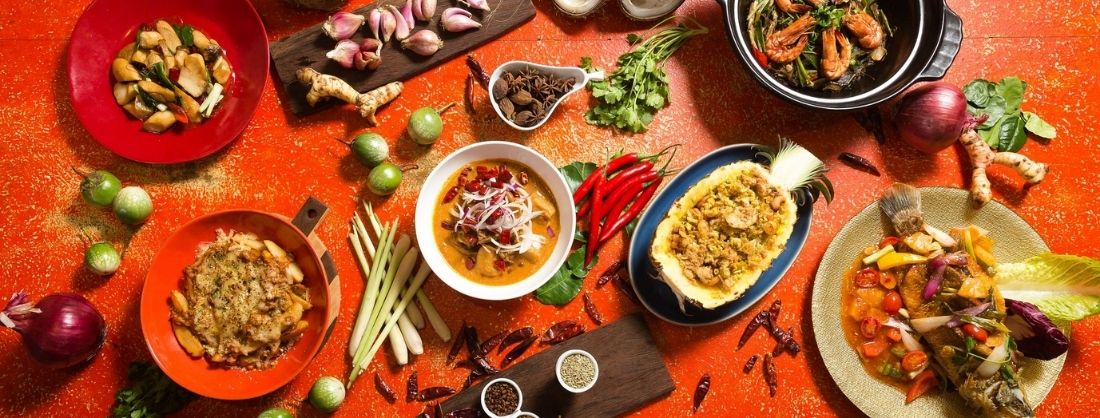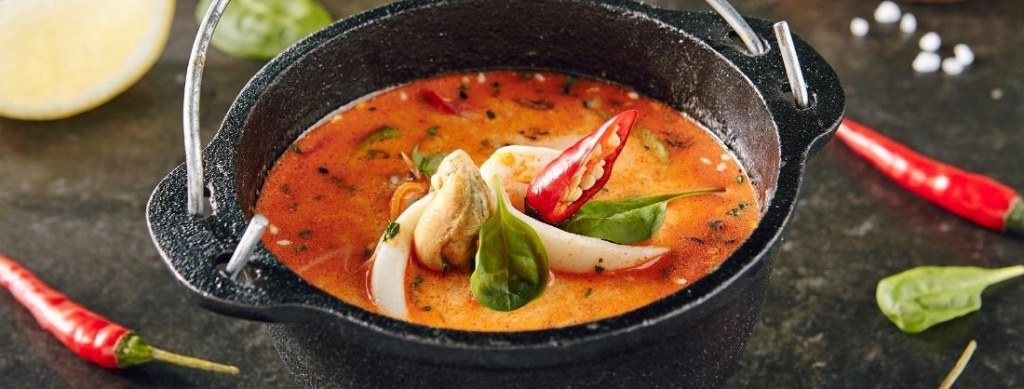
Taste of Thai
Thanks to Indian settlers, wars with neighbors and centuries of trade with China, Thai people have absorbed, retained and continue to transform the regional cuisine. Thais adopted many foreign recipes often replacing their ingredients, for instance, replacing ghee with coconut milk. Today, the harmonious combination of the five flavors - sweet, sour, salty, bitter and spicy - is the basis of Thai cuisine.
If you have been to a Thai restaurant once or twice, it does not give you a reason to believe that you are familiar with the local cuisine. In fact, cuisines of different regions of the country vary significantly.
For example, in Northern Thailand, in Chiang Mai where Thai families get together and sit in a circle on the floor for a meal and socializing, there is an incredible variety of greens and vegetables on the "table", as well as their favorite dish - naem, that is a delicacy pork sausage, and most delicious khao soi, that is a soup with crisp Chinese egg noodles in which the role of broth is played by the northern curry soup with chicken.

In the north-east of Thailand people prefer spicy "explosive" salads, fried minced meat with chilly and glutinous (sticky) rice, not crumbly rice. And for a snack here they serve a variety of insects, flavored with salty sauce. North-east of Thailand is considered the "birthplace" of the famous Thai som tam - spicy green papaya salad which is now served in all regions, without exceptions, from sidewalk cafes to upscale restaurants.
Only in central Thailand where Bangkok, the multimillion capital of the Kingdom, is located and in the former capital of Siam - Ayutthaya savory food and sweet and sour sauces prevail. It is in the "capitals of Thailand" you can enjoy the exotic meal when noodle soup is being served from a sampan boat while you are on a canal tour. On the streets of these cities you can see Thai fried noodles being wrapped in a special kind of paper so you can enjoy this dish in your apartment. Having unfolded the packed dish in the kitchen and putting it on a plate, add the essential ingredients (also packed as a takeaway): lime juice, peanuts, sugar, chili, bean sprouts - and enjoy the taste of central Thailand on your balcony with the view of the river or skyscrapers of Bangkok.
The taste of the central plains of the Kingdom of Thailand is the art of mixology of Indian spices and Chinese way of cooking. Most of the dishes are very spicy due to the large quantity of spices, especially curry and pepper. Travelling around central Thailand (Sukhothai, Ayutthaya, Bangkok) feel the color and the harmony of spice combinations of Thai green curry served here with "wet" noodles or jasmine rice.
As a rule, routes of travelers in Thailand are always directed to the east coast and south of the country. Going to the east coast (Pattaya, Rayong, Koh Chang Archipelago), the epicenter of the production of fish sauce and fruit cultivation on an industrial scale, visit the orchards. Here all the year round you can try fresh fruit such as pineapple, papaya and banana. And during spring and summer months you can enjoy lots of mango varieties, its sweet variety is part of the most popular Thai dessert with sticky rice and coconut milk. Fruit flavor of the eastern coast of Thailand pleases with a variety of exotics ranging from the queen of fruit - mangosteen to the king of fruit - ambiguous to taste durian.
In the South (Phuket, Samui, Krabi) seafood is very popular, you can have lobsters, crabs, oysters, squid, fish and even such exotic delicacies like jellyfish salad. Due to the large number of mixed fish odor the region has its own special secret of cooking with Indian saffron or turmeric to control seafood odors. Therefore, for example, the taste of yellow curry with crab is the "hallmark" of Southern Thailand.
Feel the five amazing flavors of the northern, northeastern, central, eastern and southern regions of the Kingdom of Thailand while traveling around the country and choosing cafes and restaurants with dishes of regional cuisines.
